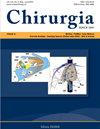Postcircumcision surgical site infection is not related to antibiotic use: a retrospective cohort in an indonesian teaching hospital
IF 0.8
Q4 SURGERY
引用次数: 0
Abstract
BACKGROUND: Male child circumcision is commonly practiced among male children in Indonesia, and broad-spectrum antibiotics, either oral or topical, are often used to prevent surgical site infections. However, various guidelines suggest not using oral antibiotics as a prophylactic in male child circumcision. This study aimed to determine the incidence of surgical site infection after circumcision without oral antibiotics, following the guidelines, at the Universitas Indonesia Hospital.METHODS: This study included all male child circumcision with and without antibiotics at RSUI between 2018 and 2019. The circumcisions were followed up for 30 days to assess whether or not the post-circumcision infection occurred. A total of 92 patients with 0-12 years old range of age and 28 patients with an abnormal penis undergoing circumcision were required to assess the association between antibiotic uses in circumcision and the postoperative infection incidence. In addition, the associations were tested with Chi-square tests and relative risk.RESULTS: Of the 92 male children undergoing circumcision, 69 took antibiotics, and 23 did not; 7 patients (7.6%) had post-circumcision surgical site infections. Of those with infections, most infections occurred within 7-30 postoperative days (5.4%) and remained for 1-2 weeks (4.3%). The infection developed in 13% of children with oral and topical antibiotics and 5.7% of children who received topical antibiotics alone. There was no significant association between antibiotic use for circumcision and the incidence of surgical site infection (P=0.35; RR = 0,25; 95% CI = 0.54 -12.67).CONCLUSIONS: Post-circumcision surgical site infection is not significantly related to oral antibiotic use. Therefore, oral antibiotics following male children’s circumcision should be limited to only those at risk of developing an infection.包皮环切术后手术部位感染与抗生素使用无关:印度尼西亚一家教学医院的回顾性队列研究
背景:在印度尼西亚,男童包皮环切术在男童中很常见,广谱抗生素,无论是口服还是外用,通常用于预防手术部位感染。然而,各种指南建议在男孩包皮环切术中不要使用口服抗生素作为预防措施。本研究旨在确定在印度尼西亚大学医院无口服抗生素的情况下,遵循指南进行包皮环切术后手术部位感染的发生率。方法:本研究纳入了2018年至2019年在RSUI接受和不接受抗生素包皮环切术的所有男童。对包皮环切术后患者进行随访30天,以评估包皮环切术后是否发生感染。共有92例0-12岁患者和28例阴茎异常行包皮环切术的患者被要求评估包皮环切术中抗生素使用与术后感染发生率之间的关系。此外,用卡方检验和相对风险检验这些关联。结果:92例接受包皮环切术的男童中,69例使用抗生素,23例未使用抗生素;包皮环切术后手术部位感染7例(7.6%)。在感染患者中,大多数感染发生在术后7-30天(5.4%),并持续1-2周(4.3%)。13%使用口服和局部抗生素的儿童发生感染,5.7%单独使用局部抗生素的儿童发生感染。包皮环切术中抗生素使用与手术部位感染发生率无显著相关性(P=0.35;Rr = 0,25;95% ci = 0.54 -12.67)。结论:包皮环切术后手术部位感染与口服抗生素使用无显著相关。因此,男孩包皮环切术后口服抗生素应仅限于那些有感染风险的儿童。
本文章由计算机程序翻译,如有差异,请以英文原文为准。
求助全文
约1分钟内获得全文
求助全文
来源期刊

Chirurgia
Medicine-Surgery
CiteScore
1.00
自引率
0.00%
发文量
75
审稿时长
4-8 weeks
期刊介绍:
Chirurgia is a bimonthly journal. In Chirurgia, original papers in the area of general surgery which neither
appeared, nor were sent for publication in other periodicals, can be published. You can send original articles,
new surgical techniques, or comprehensive general reports on surgical topics, clinical case presentations and,
depending on publication space, - reviews of some articles of general interest to surgeons from other publications.
Chirurgia is also a place for sharing information about the activity of various branches of the Romanian Society of
Surgery, information on Congresses and Symposiums organized by the Romanian Society of Surgery and
participation notes in other scientific meetings.
Letters to the editor: Letters commenting on papers published in Chirurgia are welcomed. They should contain
substantive ideas and commentaries supported by appropriate data, and should not exceed 2 pages. Please
submit these letters to the editor through our online system.
 求助内容:
求助内容: 应助结果提醒方式:
应助结果提醒方式:


